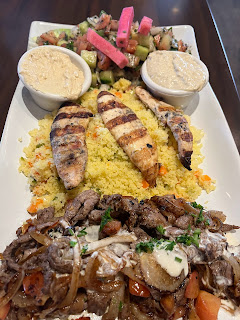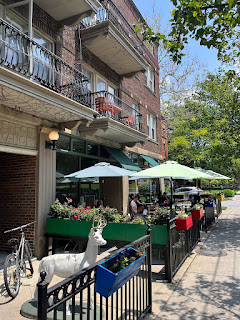Lebanon!
There were several Lebanese restaurants to choose from in Cleveland. Aladdin's is probably the most prominent one with a bakery and market on Carnegie along with several other restaurant locations. I've been to Aladdin's several times already as well as Boaz which is like a Lebanese Chipotle, so I decided to try Taza's which seems to top the lists of best Lebanese food in Cleveland. There are several locations and I visited the Chagrin Blvd. spot in the Eton shopping plaza. There is a nice patio, but I chose to dine inside thanks to the Canadian wildfires wreaking havoc on our air quality here. It was a little more upscale than I expected and I felt underdressed in my cutoffs and sandals. Whoops. I was used to the fast casual feel of Aladdin's, Boaz, etc.
I went in with my plan of attack - order one dish that covered a lot of ground (even though I wanted so many other things!) - and chose the Tour of Lebanon – Taste of Taza. It had shawarma, shish tawook, vegetable couscous, Lebanese salata, hummos, and baba. So while my intention was to show restraint, I still chose the largest plate on the menu. I gotta be me.- Lebanese salata - mixed greens topped with chopped tomatoes, cucumbers, green peppers, onions, kalamata olives, and feta and tossed in a lemon herb vinaigrette. I love Lebanese salata - so crunchy, fresh, and full of flavor.
- Hummos and baba - I think we're all familiar with these. The baba was one of the better ones I've tried - super garlickly and smooth.
- Vegetable couscous and shish tawook - the couscous was flavorful and fluffy. The shish tawook - cuts of chicken tenders, brushed with a zesty lemon and garlic blend - were eh.
- The real star of the plate - shawarma - seasoned strips of grilled beef topped with tomato, onion, sumac, parsley and pine nuts and served with tahini sauce. This was INCREDIBLE. I've had tons of shawarma in my life, but this one gets the gold star. I'm coming back for just a plate of this!
I couldn't find specific information about the Lebanese population in Cleveland other than it's "significant" and "well organized." My trusty resource, Case Western's Encyclopedia of Cleveland, gives some history of Arab-Americans and their immigration and settlement in Cleveland:
Rather than being driven from the Old World by oppression and starvation, Arabs were drawn to America by economic opportunity; many originally planned to return home after making their fortunes. The political destabilization in the Near East with the approach of World War I, and some dissatisfaction with the hegemony of the Turkish Ottoman Empire, provided additional but secondary incentives for going abroad. The first Arab immigrant to arrive in Cleveland, about 100 years ago, is said to have been a peddler from the East Coast. The city annual report first recorded Arab immigrants in Cleveland in 1895, listing 12 individuals. That source indicates that between 1895-1907, 241 Arab immigrants came to Cleveland, the majority men who worked as peddlers, factory laborers, or in construction. Many, after saving enough money, established small businesses, particularly grocery stores, fruit stands, restaurants, dry goods stores, and contracting firms. Increasingly, they brought wives, children, and other family members to the U.S., especially around World War I. Nearly all of these immigrants came from Syria, especially from that part which today is the separate country of Lebanon. In Cleveland they initially settled in the Haymarket district and across the Central Viaduct in Tremont. However, as they and their descendants prospered, they moved to various areas of Cleveland and its suburbs.
By 1960 Cleveland's Arab population had increased to 1,841, with most individuals coming from Lebanon, Egypt, the occupied west bank of Palestine, and Syria. The figure for 1970 was 832, reflecting the general decline in Cleveland's population during the period. However, by 1990 over 900 Arab immigrants lived in Cleveland, bearing witness to a new influx from the Middle East. Many of the new arrivals chose to live on the city's west side, and by the mid-1990s a number of small food shops and restaurants serving the Arab community were located along Lorain Ave., west of W. 117th St. Estimates for the total number of Arab-Americans (including individuals of American birth and mixed parentage) residing in Greater Cleveland during the 1970s and 1980s varied from 15,000 to 35,000. This more recent wave of Arab immigration differed from the earlier one. First, the motivation was often political rather than economic, with at least some of the immigrants planning to return home when conditions permitted. Second, these later immigrants were on the average better-educated; many came with the education and experience to enter academia and the professions, or with sufficient funds to start small businesses. Third, the religious background of the new immigrants was more varied, with more Muslims, as well as Coptic Christians from Egypt.
The Lebanese Cultural Garden is under development. You can learn more about their plans here: https://www.lebaneseculturalgarden.org/about.html
30 down, 22 to go! (I think I can, I think I can...)
Taza
28601 Chagrin Blvd.
Woodmere, OH
216.464.4000
Hours:
SUN - THURS | 11am-9pm
FRI - SAT | 11am-9:30Pm




Comments
Post a Comment